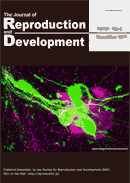57 巻, 2 号
April
選択された号の論文の23件中1~23を表示しています
- |<
- <
- 1
- >
- >|
SRD Young Investigator Award
-
2011 年 57 巻 2 号 p. 169-175
発行日: 2011年
公開日: 2011/05/07
PDF形式でダウンロード (648K) -
2011 年 57 巻 2 号 p. 176-182
発行日: 2011年
公開日: 2011/05/07
PDF形式でダウンロード (265K) -
2011 年 57 巻 2 号 p. 183-187
発行日: 2011年
公開日: 2011/05/07
PDF形式でダウンロード (217K)
Original Article
-
原稿種別: -Original Article-
2011 年 57 巻 2 号 p. 188-196
発行日: 2011年
公開日: 2011/05/07
[早期公開] 公開日: 2010/11/10PDF形式でダウンロード (206K) -
原稿種別: -Original Article-
2011 年 57 巻 2 号 p. 197-202
発行日: 2011年
公開日: 2011/05/07
[早期公開] 公開日: 2010/11/25PDF形式でダウンロード (326K) -
原稿種別: -Original Article-
2011 年 57 巻 2 号 p. 203-211
発行日: 2011年
公開日: 2011/05/07
[早期公開] 公開日: 2010/12/03PDF形式でダウンロード (427K) -
原稿種別: -Original Article-
2011 年 57 巻 2 号 p. 212-216
発行日: 2011年
公開日: 2011/05/07
[早期公開] 公開日: 2010/11/25PDF形式でダウンロード (129K) -
原稿種別: -Original Article-
2011 年 57 巻 2 号 p. 217-222
発行日: 2011年
公開日: 2011/05/07
[早期公開] 公開日: 2010/12/09PDF形式でダウンロード (323K) -
原稿種別: -Original Article-
2011 年 57 巻 2 号 p. 223-228
発行日: 2011年
公開日: 2011/05/07
[早期公開] 公開日: 2010/11/25PDF形式でダウンロード (400K) -
原稿種別: -Original Article-
2011 年 57 巻 2 号 p. 229-235
発行日: 2011年
公開日: 2011/05/07
[早期公開] 公開日: 2010/11/25PDF形式でダウンロード (577K) -
原稿種別: -Original Article-
2011 年 57 巻 2 号 p. 236-241
発行日: 2011年
公開日: 2011/05/07
[早期公開] 公開日: 2010/12/03PDF形式でダウンロード (214K) -
原稿種別: -Original Article-
2011 年 57 巻 2 号 p. 242-248
発行日: 2011年
公開日: 2011/05/07
[早期公開] 公開日: 2010/12/09PDF形式でダウンロード (267K) -
原稿種別: -Original Article-
2011 年 57 巻 2 号 p. 249-255
発行日: 2011年
公開日: 2011/05/07
[早期公開] 公開日: 2010/12/22PDF形式でダウンロード (147K) -
原稿種別: -Original Article-
2011 年 57 巻 2 号 p. 256-261
発行日: 2011年
公開日: 2011/05/07
[早期公開] 公開日: 2010/12/09PDF形式でダウンロード (520K) -
原稿種別: -Original Article-
2011 年 57 巻 2 号 p. 262-266
発行日: 2011年
公開日: 2011/05/07
[早期公開] 公開日: 2011/01/14PDF形式でダウンロード (216K) -
原稿種別: -Original Article-
2011 年 57 巻 2 号 p. 267-272
発行日: 2011年
公開日: 2011/05/07
[早期公開] 公開日: 2011/01/14PDF形式でダウンロード (249K) -
原稿種別: -Original Article-
2011 年 57 巻 2 号 p. 273-279
発行日: 2011年
公開日: 2011/05/07
[早期公開] 公開日: 2011/01/18PDF形式でダウンロード (614K) -
原稿種別: -Original Article-
2011 年 57 巻 2 号 p. 280-287
発行日: 2011年
公開日: 2011/05/07
[早期公開] 公開日: 2011/01/14PDF形式でダウンロード (261K) -
原稿種別: -Original Article-
2011 年 57 巻 2 号 p. 288-295
発行日: 2011年
公開日: 2011/05/07
[早期公開] 公開日: 2011/01/06PDF形式でダウンロード (420K) -
原稿種別: -Original Article-
2011 年 57 巻 2 号 p. 296-302
発行日: 2011年
公開日: 2011/05/07
[早期公開] 公開日: 2011/01/18PDF形式でダウンロード (887K)
Technology Report
-
原稿種別: -Technology Report-
2011 年 57 巻 2 号 p. 303-306
発行日: 2011年
公開日: 2011/05/07
[早期公開] 公開日: 2010/12/03PDF形式でダウンロード (200K) -
原稿種別: -Technology Report-
2011 年 57 巻 2 号 p. 307-311
発行日: 2011年
公開日: 2011/05/07
[早期公開] 公開日: 2010/12/09PDF形式でダウンロード (173K) -
Cloned Porcine Embryos can Maintain Developmental Ability after Cryopreservation at the Morula Stage原稿種別: -Technology Report-
2011 年 57 巻 2 号 p. 312-316
発行日: 2011年
公開日: 2011/05/07
[早期公開] 公開日: 2011/01/14PDF形式でダウンロード (848K)
- |<
- <
- 1
- >
- >|
